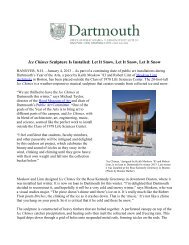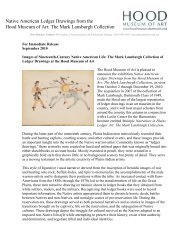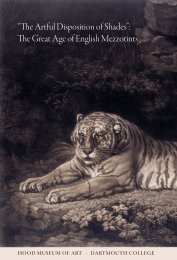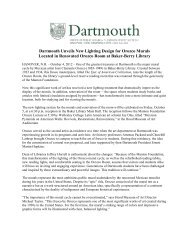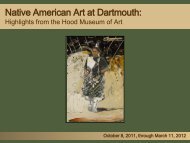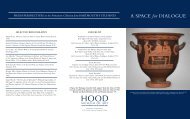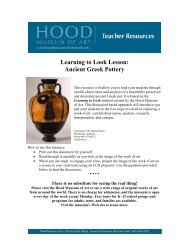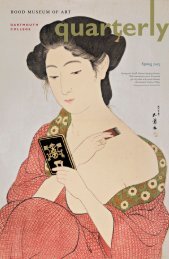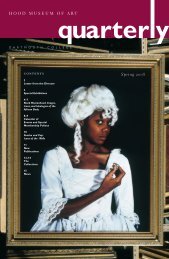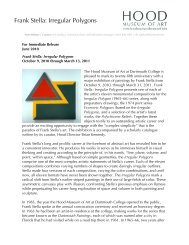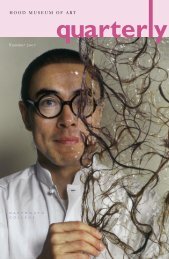Fall 2012 - Hood Museum of Art - Dartmouth College
Fall 2012 - Hood Museum of Art - Dartmouth College
Fall 2012 - Hood Museum of Art - Dartmouth College
You also want an ePaper? Increase the reach of your titles
YUMPU automatically turns print PDFs into web optimized ePapers that Google loves.
New Acquisition<br />
St a c e y St e e r s<br />
Nig h t<br />
Hun t e r<br />
Hou s e<br />
August 25–December 16<br />
Denver-based multimedia artist<br />
Stacey Steers conceived her Night<br />
Hunter House around her sixteenminute<br />
handmade film, shot in<br />
35mm color, titled Night Hunter<br />
(2011). The film, incorporated into<br />
the house itself, is composed <strong>of</strong> more<br />
than four thousand collages, an<br />
intensely laborious process that<br />
Steers completed over a four-year<br />
period. The music and sound from<br />
the film, which are also part <strong>of</strong> this<br />
work, are by Larry Polansky, Jacob<br />
H. Strauss 1922 Pr<strong>of</strong>essor in Music at<br />
<strong>Dartmouth</strong> <strong>College</strong>. The film seamlessly<br />
incorporates images <strong>of</strong> silent<br />
film star Lillian Gish (1893–1993)<br />
taken from her films Broken Blossoms,<br />
Way Down East (part <strong>of</strong> which<br />
was filmed in White River Junction,<br />
Vermont), and True Heart Susie,<br />
among others. Night Hunter House<br />
literally places Gish in a nightmare<br />
world filled with snakes, giant moths,<br />
pulsating eggs, and a deep, dark forest,<br />
into which she disappears at the<br />
end <strong>of</strong> the film in a moment reminiscent<br />
<strong>of</strong> classic fairy tales, although<br />
her fate is far from clear.<br />
This three-foot-tall black Victorian<br />
dollhouse was built by Steers<br />
with design and construction help<br />
from architect Mark S<strong>of</strong>ield and<br />
Michael Schliske <strong>of</strong> Steamboat<br />
Woodworks. It is outfitted with ten<br />
rooms that recreate those within<br />
which the scenes from the film take<br />
place, and each room contains a<br />
small HDTV screen that loops the<br />
segment <strong>of</strong> the film connected to<br />
the space. The intricately furnished<br />
interiors are filled with furniture,<br />
light fixtures, antique lace, curtains,<br />
implements, bird eggs, and moth<br />
specimens. The base <strong>of</strong> the house<br />
depicts the forest at the end <strong>of</strong> the<br />
film. Viewers therefore are invited<br />
to experience the dream along with<br />
Gish by peering into each <strong>of</strong> the<br />
windows <strong>of</strong> the house and observing<br />
its contents as well as the film.<br />
Night Hunter House evokes the<br />
surrealist landscapes and collages<br />
<strong>of</strong> Max Ernst and the otherworldly<br />
boxes <strong>of</strong> his contemporary Joseph<br />
Cornell. Steers also cites contemporary<br />
artist William Kentridge as a<br />
stylistic influence. In addition, the<br />
structure or image <strong>of</strong> the house is one<br />
that has been used by feminist artists<br />
to explore femininity and the roles <strong>of</strong><br />
Stacey Steers, Night Hunter House, 2011,<br />
mixed media, music and sound by Larry Polansky.<br />
Purchased through the Julia L. Whittier<br />
Fund and the Claire and Richard P. Morse<br />
1953 Fund; <strong>2012</strong>.6.<br />
women in society. Steers reverses the<br />
idea <strong>of</strong> the house as a “safe haven”<br />
in this work. The “dangerous” forest<br />
that threatened Little Red Riding<br />
<strong>Hood</strong>—among other female<br />
archetypes—becomes the place <strong>of</strong><br />
escape, although its pulsating darkness<br />
is no less threatening than the<br />
activity within the house.<br />
A central theme <strong>of</strong> Night Hunter<br />
House is that <strong>of</strong> transition, both biological<br />
and metaphorical. Not only<br />
does Steers’s filmmaking process <strong>of</strong><br />
handmade collage embrace transition<br />
by its very nature, but the visitor’s<br />
experience <strong>of</strong> the house, from<br />
the tidy foyer and living room below<br />
to the violently disrupted attic above,<br />
parallels the protagonist’s transition<br />
within it. As she slowly realizes she<br />
is changing from human to bird, she<br />
encounters another uniquely female<br />
state <strong>of</strong> impermanence: gestation.<br />
Indeed, Steers draws our attention to<br />
the relationship between the house<br />
and the female body—one could<br />
argue that the house is a body—and<br />
peering into its windows thereby<br />
implies a certain intimacy on the<br />
part <strong>of</strong> the viewer.<br />
A new acquisition on view to<br />
the public for the first time, Night<br />
Hunter House exemplifies contemporary<br />
multi-media and collaborative<br />
art making. Because <strong>of</strong> the multifaceted<br />
themes that Steers explores, it<br />
has the potential to connect to the<br />
curriculum at <strong>Dartmouth</strong> <strong>College</strong><br />
in a variety <strong>of</strong> disciplines, including<br />
art history, studio art, women’s and<br />
gender studies, French and Italian,<br />
philosophy, music, history, theater,<br />
English, and film and media studies.<br />
Jul i e t t e Bi a n c o<br />
Assistant Director<br />
HOOD QUARTERLY 13



